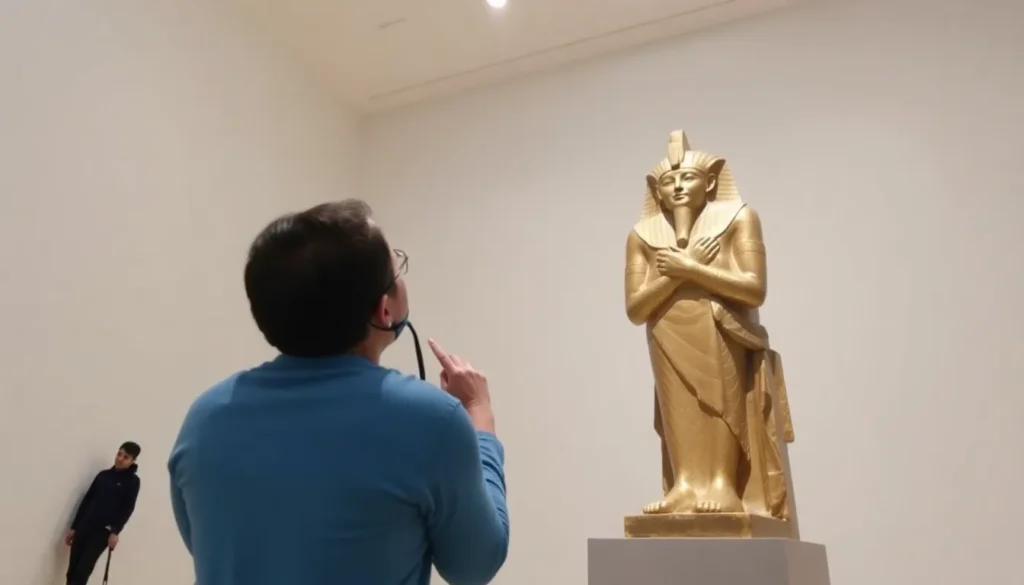Visit the Egyptian Museum in Barcelona

Just a stone's throw from the iconic Casa Batlló and the bustling Passeig de Gracia lies the Egyptian Museum of Barcelona, a treasure trove for history enthusiasts and Egypt lovers alike. A visit here is not merely a walk through a museum; it's an immersive journey into the rich tapestry of one of the world's most fascinating civilizations. In this article, we’ll delve into what to expect during your visit to this remarkable museum and provide essential tips to enhance your experience.
⭐ For more insights, check out our article on the best museums in Barcelona.
To enrich your visit, we also recommend our piece on the (not so) brief summary of Egypt's history. For the latest updates and information, visit the official site of Visit Barcelona, your go-to resource for all things related to the Catalan capital.
Established in 1994, the Egyptian Museum of Barcelona holds the distinction of being the first museum in Spain dedicated exclusively to Ancient Egypt. Its creation was the vision of Jordi Clos Llombart, a Barcelona-based entrepreneur with a profound passion for Egyptology. Over the past three decades, the museum's collection has burgeoned, positioning it as a significant reference point for scholars and enthusiasts far beyond Egypt's borders.
Exploring the Wonders of the Egyptian Museum of Barcelona
The museum spans three floors, housing over 2,000 square meters filled with more than a thousand archaeological artifacts from Ancient Egypt. These treasures are organized into eight thematic rooms, each offering a unique glimpse into the culture and life of this ancient civilization. Additionally, the museum frequently hosts intriguing temporary exhibitions, so be sure to check their website for current offerings.
Here are the eight themes that guide the museum's extensive collection:
1. The Pharaoh
The journey begins with a deep dive into the life of the pharaoh, the most pivotal figure in Ancient Egypt. Here, you’ll learn how the pharaoh was regarded as a living deity, discover the symbols associated with their power (such as the crowns of Upper and Lower Egypt, the cartouche, and the upright cobra), and marvel at ancient artifacts, including statue fragments and stelae depicting Cleopatra making offerings.
2. Hieroglyphic Writing
This fascinating section showcases artifacts that highlight the significance of this sacred writing system. It’s astonishing to consider that it wasn't until 1822 that French scholar Champollion deciphered these enigmatic symbols, thanks to the discovery of the Rosetta Stone, now housed in the British Museum in London. This stone featured the same text in three scripts: hieroglyphic, demotic, and Greek, allowing for a groundbreaking translation of the previously indecipherable symbols.
Among the showcased items are statues of the deity Imhotep, clutching a papyrus scroll, and wall relief fragments depicting a nobleman engaged in writing. During our visit, a replica of the Rosetta Stone made an appearance on the ground floor, adding to the allure of this section.
3. Jewelry
The craftsmanship of Egyptian jewelers is nothing short of breathtaking. This section features exquisite artifacts such as necklaces, amulets (including the iconic scarab), rings, and ceremonial clothing, each illustrating the extraordinary skill of the artisans who created them.
4. Stone and Ceramics
The mastery displayed in stonework and ceramics laid the groundwork for the architectural marvels that would follow in Ancient Egypt. Many of the techniques developed in this era would later be employed in constructing some of the most stunning temples of Egypt.
5. Cosmetics and Eroticism
This intriguing section sheds light on the Egyptians' dedication to personal grooming, viewing the body as a temple worthy of care. Notable artifacts include a mirror adorned with deities Osiris, Isis, and Nephthys, containers for kohl and ointments, a bed, and, surprisingly, erotic statuettes featuring exaggerated phallic representations, which are quite rare in Egyptian tradition.
6. Funerary Beliefs and Practices
In Egyptian culture, death was a critical transition to eternal life, making the practice of mummification paramount. In this room, you'll encounter statues of Isis and Osiris, canopic jars, and a mummy known as ‘The Lady of Kemet,’ believed to be a 15-year-old girl from an affluent family, alongside several mummified animals.
7. Funerary Dependencies
For the Egyptians, tombs were sacred eternal homes, containing treasures such as amulets, food offerings, and valuable artifacts to accompany the deceased. This section captivates with funerary masks, sarcophagi, miniature models of tombs, and ushabti figurines, including those of Amenemopet.
8. Cult Chapels and Deities of Egypt
The last three rooms are dedicated to the worship of the gods. In Ancient Egypt, temples were viewed as the homes of the gods, places for devotion and offerings, integral to daily life. A highlight of this collection includes various divine figures, many associated with animals and their traits—like the falcon, revered as Horus due to its soaring flight near the sun.
Essential Tips for Visiting the Egyptian Museum of Barcelona
To make the most of your visit to the Egyptian Museum of Barcelona, here’s a compilation of useful information to keep in mind:
› Ticket Prices
The general admission fee is €12. Reduced tickets are available for €8.50 for youth aged 13-18, students, holders of the Carnet Jove, the unemployed, large families, single-parent families, and seniors over 65. Children aged 6-12 can enter for €5, while younger children enjoy free admission. All tickets include access to the permanent collection and temporary exhibitions.
→ Secure your tickets in advance here or purchase them at the museum box office.
› Where is the Egyptian Museum of Barcelona Located?
You can find the museum at Calle Valencia, 284, just a stone's throw from Passeig de Gracia and Casa Batlló. The nearest metro stations are "Passeig de Gracia" (lines 2, 3, and 4) and "Diagonal" (lines 3 and 4). Several urban bus lines also stop nearby.
If you're exploring Barcelona and seeking a unique experience that will charm both adults and children alike, the Egyptian Museum of Barcelona is a must-visit!
To enhance your understanding of the museum, consider checking out this video that provides a complete overview of the Egyptian Museum of Barcelona:
For those looking to save on their trip, here are some tips:
- Compare and find cheap flights here.
- Discover accommodation at the best prices here.
- Book activities and excursions in Spanish here.
- Receive a 5% discount on your travel insurance with IATI here.
- Arrange airport transfers here.
- Get a €10 gift when booking transport across Europe here.
- Learn how to withdraw money without commissions here.
- Enjoy a 5% discount on your eSIM from Holafly here.
- Rent a car with the best deals here.
- Find the best books and travel guides here.
- Explore all our articles about Spain.






Deja una respuesta